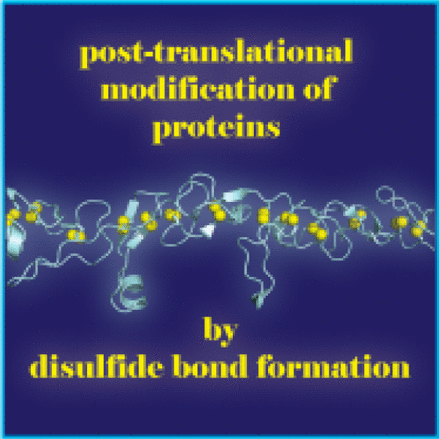当前位置:
X-MOL 学术
›
Chem. Rev.
›
论文详情
Our official English website, www.x-mol.net, welcomes your
feedback! (Note: you will need to create a separate account there.)
Chemistry and Enzymology of Disulfide Cross-Linking in Proteins
Chemical Reviews ( IF 51.4 ) Pub Date : 2017-07-12 00:00:00 , DOI: 10.1021/acs.chemrev.7b00123 Deborah Fass 1 , Colin Thorpe 2
Chemical Reviews ( IF 51.4 ) Pub Date : 2017-07-12 00:00:00 , DOI: 10.1021/acs.chemrev.7b00123 Deborah Fass 1 , Colin Thorpe 2
Affiliation

|
Cysteine thiols are among the most reactive functional groups in proteins, and their pairing in disulfide linkages is a common post-translational modification in proteins entering the secretory pathway. This modest amino acid alteration, the mere removal of a pair of hydrogen atoms from juxtaposed cysteine residues, contrasts with the substantial changes that characterize most other post-translational reactions. However, the wide variety of proteins that contain disulfides, the profound impact of cross-linking on the behavior of the protein polymer, the numerous and diverse players in intracellular pathways for disulfide formation, and the distinct biological settings in which disulfide bond formation can take place belie the simplicity of the process. Here we lay the groundwork for appreciating the mechanisms and consequences of disulfide bond formation in vivo by reviewing chemical principles underlying cysteine pairing and oxidation. We then show how enzymes tune redox-active cofactors and recruit oxidants to improve the specificity and efficiency of disulfide formation. Finally, we discuss disulfide bond formation in a cellular context and identify important principles that contribute to productive thiol oxidation in complex, crowded, dynamic environments.
中文翻译:

蛋白质中二硫键交联的化学和酶学
半胱氨酸硫醇是蛋白质中反应性最高的官能团之一,它们在二硫键中的配对是进入分泌途径的蛋白质中常见的翻译后修饰。这种适度的氨基酸变化,即从并列的半胱氨酸残基中仅去除一对氢原子,与大多数其他翻译后反应所具有的实质性变化形成对比。但是,包含二硫键的蛋白质种类繁多,交联对蛋白质聚合物的行为产生深远影响,细胞内二硫键形成途径中的多种多样的参与者以及可以采取二硫键形成的独特生物学环境掩饰了过程的简单性。在这里,我们通过回顾半胱氨酸配对和氧化背后的化学原理,为了解体内二硫键形成的机理和后果奠定了基础。然后,我们展示了酶如何调节氧化还原活性辅助因子并募集氧化剂以提高二硫键形成的特异性和效率。最后,我们讨论了在细胞环境中二硫键的形成并确定了在复杂,拥挤,动态环境中有助于生产硫醇氧化的重要原理。
更新日期:2017-07-12
中文翻译:

蛋白质中二硫键交联的化学和酶学
半胱氨酸硫醇是蛋白质中反应性最高的官能团之一,它们在二硫键中的配对是进入分泌途径的蛋白质中常见的翻译后修饰。这种适度的氨基酸变化,即从并列的半胱氨酸残基中仅去除一对氢原子,与大多数其他翻译后反应所具有的实质性变化形成对比。但是,包含二硫键的蛋白质种类繁多,交联对蛋白质聚合物的行为产生深远影响,细胞内二硫键形成途径中的多种多样的参与者以及可以采取二硫键形成的独特生物学环境掩饰了过程的简单性。在这里,我们通过回顾半胱氨酸配对和氧化背后的化学原理,为了解体内二硫键形成的机理和后果奠定了基础。然后,我们展示了酶如何调节氧化还原活性辅助因子并募集氧化剂以提高二硫键形成的特异性和效率。最后,我们讨论了在细胞环境中二硫键的形成并确定了在复杂,拥挤,动态环境中有助于生产硫醇氧化的重要原理。











































 京公网安备 11010802027423号
京公网安备 11010802027423号